
LESS
Preprint: Less: Selecting Influential Data for Targeted Instruction Tuning
Stars: 234
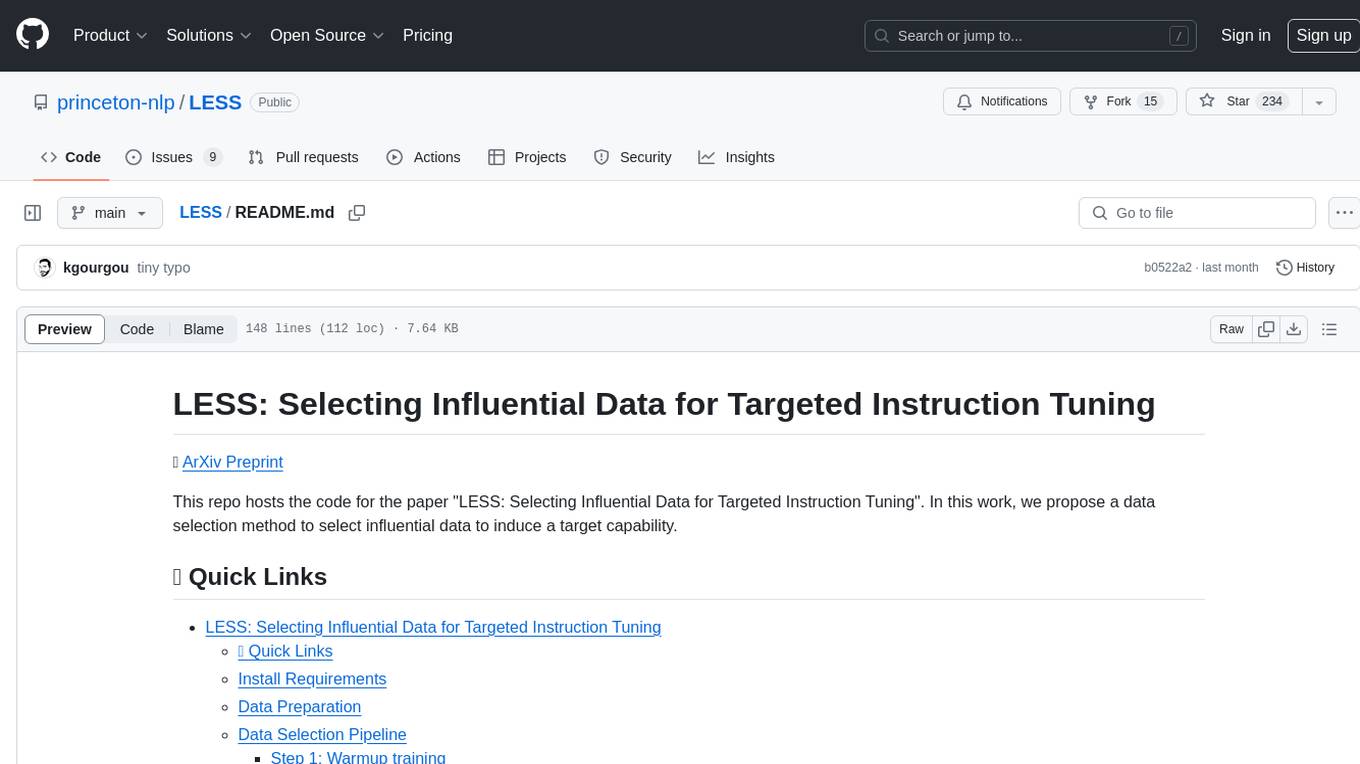
This repository contains the code for the paper 'LESS: Selecting Influential Data for Targeted Instruction Tuning'. The work proposes a data selection method to choose influential data for inducing a target capability. It includes steps for warmup training, building the gradient datastore, selecting data for a task, and training with the selected data. The repository provides tools for data preparation, data selection pipeline, and evaluation of the model trained on the selected data.
README:
This repo hosts the code for the paper "LESS: Selecting Influential Data for Targeted Instruction Tuning". In this work, we propose a data selection method to select influential data to induce a target capability.
Step 1: To get started with this repository, you'll need to follow these installation steps. Before proceeding, make sure you have Pytorch installed.
pip3 install torch==2.1.2 torchvision torchaudio
Step 2: Then install the rest of the required packages:
cd LESS
pip install -r requirement.txt
Step 3: Finally, install the less package in editable mode to make it accessible for your development environment:
pip install -e .
We follow the open-instruct repo to prepare four instruction tuning datasets. In our project, we utilize a combination of four training datasets: Flan v2, COT, Dolly, and Open Assistant. For the purposes of evaluation, we employ three additional datasets: MMLU, Tydiqa, and BBH. A processed version of these files are available here.
To enhance downstream performance from data selection, it's crucial to start with a warmup training step. This involves selecting a small portion of your entire dataset to train using the LoRA method. Follow these steps for effective warmup training:
DATA_DIR=../data
MODEL_PATH=meta-llama/Llama-2-7b-hf
PERCENTAGE=0.05 # percentage of the full data to train, you can specify the training file you want to use in the script
DATA_SEED=3
JOB_NAME=llama2-7b-p${PERCENTAGE}-lora-seed${DATA_SEED}
./less/scripts/train/warmup_lora_train.sh "$DATA_DIR" "$MODEL_PATH" "$PERCENTAGE" "$DATA_SEED" "$JOB_NAME"Once the initial warmup training stage is completed, we will collect gradients for the entire training dataset. For each checkpoint, our goal is to obtain the gradients of all the training data that we would like to select from. An example script is shown below.
CKPT=105
TRAINING_DATA_NAME=dolly
TRAINING_DATA_FILE=../data/train/processed/dolly/dolly_data.jsonl # when changing data name, change the data path accordingly
GRADIENT_TYPE="adam"
MODEL_PATH=../out/llama2-7b-p0.05-lora-seed3/checkpoint-${CKPT}
OUTPUT_PATH=../grads/llama2-7b-p0.05-lora-seed3/${TRAINING_DATA_NAME}-ckpt${CKPT}-${GRADIENT_TYPE}
DIMS="8192"
./less/scripts/get_info/get_train_lora_grads.sh "$TRAINING_DATA_FILE" "$MODEL_PATH" "$OUTPUT_PATH" "$DIMS" "$GRADIENT_TYPE"Ideally, you would aim to create a datastore that encompasses a gradient of all the checkpoints and training data from which you wish to choose.
To select data for a particular downstream task, it's necessary to first prepare data specific to that task, using the same instruction-tuning prompt format as was employed during training. We have set up data loading modules for three evaluation datasets featured in our work: BBH, TydiQA, and MMLU. If you're interested in data selection for additional tasks, you can expand the less/data_selection/get_validation_dataset.py script to accommodate those tasks. Similar to obtaining gradients for training data, run the following script. The primary difference is that this process will yield SGD gradients for the validation data, following the formulation of the influence estimation.
CKPT=105
TASK=tydiqa
MODEL_PATH=../out/llama2-7b-p0.05-lora-seed3/checkpoint-${CKPT}
OUTPUT_PATH=../grads/llama2-7b-p0.05-lora-seed3/${TASK}-ckpt${CKPT}-sgd # for validation data, we always use sgd
DATA_DIR=../data
DIMS="4096 8192" # We use 8192 as our default projection dimension
./less/scripts/get_info/get_eval_lora_grads.sh "$TASK" "$DATA_DIR" "$MODEL_PATH" $OUTPUT_PATH "$DIMS"You should gain the gradients of the validation data for all the checkpoints you used for building the gradient datastore in the previous step. After obtaining the gradients for the validation data, we can then select data for the task. The following script will calculate the influence score for each training data point, and select the top-k data points with the highest influence score.
DIM=8192 # decide which dimension to use
GRADIENT_PATH=../grads/llama2-7b-p0.05-lora-seed3/{}-ckpt{}-adam/dim${DIM}
TRAIN_FILE_NAMES="flan_v2 cot dolly oasst1"
CKPTS="105 211 317 420" # checkpoing index
CHECKPOINT_WEIGHTS="1.6877e-05 1.2859e-05 7.7030e-06 2.5616e-06" # average lr of the epoch
VALIDATION_GRADIENT_PATH=../grads/llama2-7b-p0.05-lora-seed3/{}-ckpt{}-sgd/dim${DIM}
TARGET_TASK_NAMES="tydiqa"
SELECTED_DATA_OUTPUT_PATH="../selected_data"
./less/scripts/data_selection/matching.sh "$GRADIENT_PATH" "$TRAIN_FILE_NAMES" "$CKPTS" "$CHECKPOINT_WEIGHTS" "$VALIDATION_GRADIENT_PATH" "$TARGET_TASK_NAMES" "$SELECTED_DATA_OUTPUT_PATH"The influence score for each training data point will be saved in the OUTPUT_PATH directory. You can use the following script to select the top-k data points with the highest influence score.
python3 -m less.data_selection.write_selected_data \
--target_task_names ${TARGET_TASK_NAMES} \
--train_file_names ${TRAIN_FILE_NAMES} \
--train_files ../data/train/processed/dolly/dolly_data.jsonl ../data/train/processed/oasst1/oasst1_data.jsonl \
--output_path $SELECTED_DATA_OUTPUT_PATH \
--percentage 0.05After selecting the data, you can use the following script to train the model with the selected data.
TARGET_TASK_NAME="tydiqa"
PERCENTAGE=0.05
TRAIN_FILES=../selected_data/${TARGET_TASK_NAME}/top_p${PERCENTAGE}.jsonl
MODEL_PATH=meta-llama/Llama-2-7b-hf
JOB_NAME=llama2-7b-less-p${PERCENTAGE}-lora
./less/scripts/train/lora_train.sh "$TRAIN_FILES" "$MODEL_PATH" "$JOB_NAME" Note that you can also perform full-parameter finetuning by removing the lora training parameters.
Please follow the instructions in the evaluation folder to evaluate the performance of the model trained on the selected data.
If you have any questions related to the code or the paper, feel free to email Mengzhou ([email protected]). If you encounter any problems when using the code, or want to report a bug, you can open an issue. Please try to specify the problem with details so we can help you better and quicker!
Please cite our paper if you find the repo helpful in your work:
@article{xia2024less,
title={Less: Selecting Influential Data for Instruction Tuning},
author={Xia, Mengzhou and Malladi, Sadhika and Gururangan, Suchin and Arora, Sanjeev and Chen, Danqi},
year={2024}
}For Tasks:
Click tags to check more tools for each tasksFor Jobs:
Alternative AI tools for LESS
Similar Open Source Tools

LESS
This repository contains the code for the paper 'LESS: Selecting Influential Data for Targeted Instruction Tuning'. The work proposes a data selection method to choose influential data for inducing a target capability. It includes steps for warmup training, building the gradient datastore, selecting data for a task, and training with the selected data. The repository provides tools for data preparation, data selection pipeline, and evaluation of the model trained on the selected data.
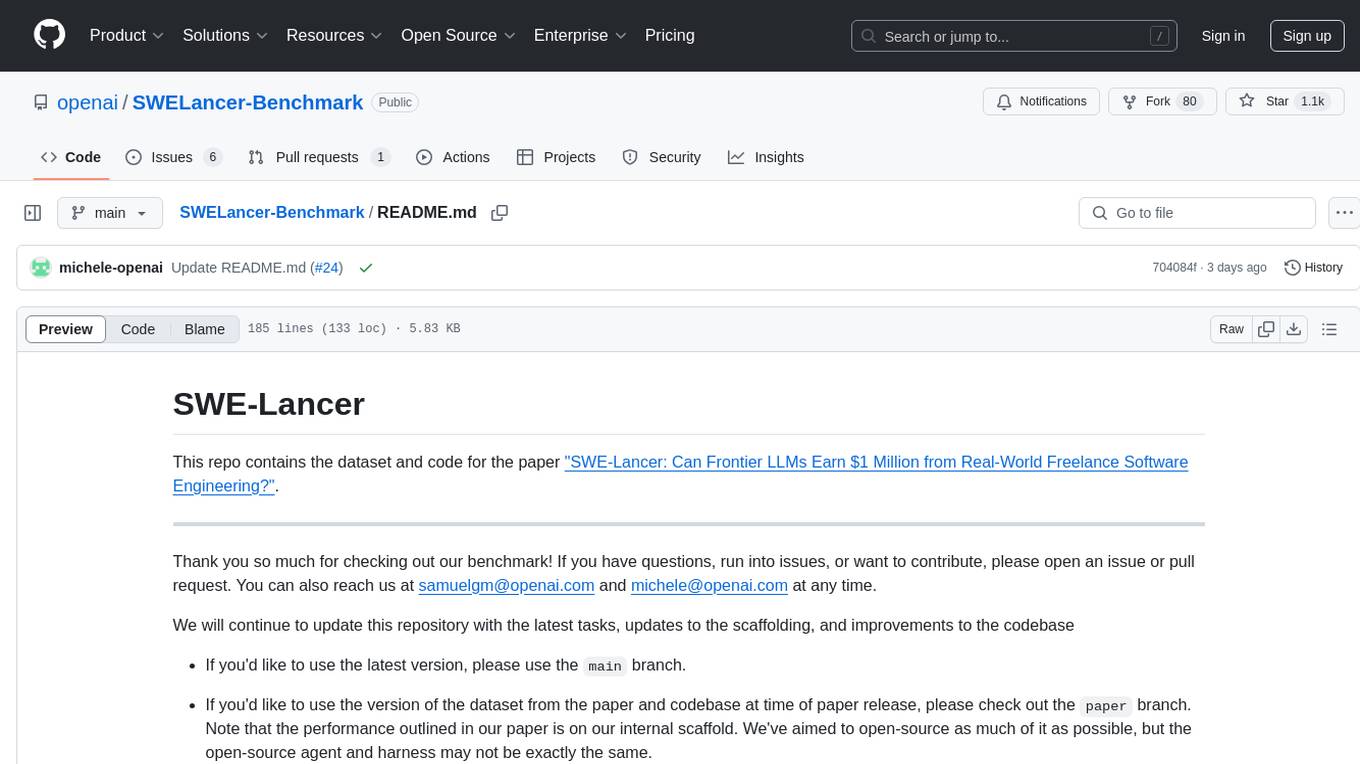
SWELancer-Benchmark
SWE-Lancer is a benchmark repository containing datasets and code for the paper 'SWE-Lancer: Can Frontier LLMs Earn $1 Million from Real-World Freelance Software Engineering?'. It provides instructions for package management, building Docker images, configuring environment variables, and running evaluations. Users can use this tool to assess the performance of language models in real-world freelance software engineering tasks.
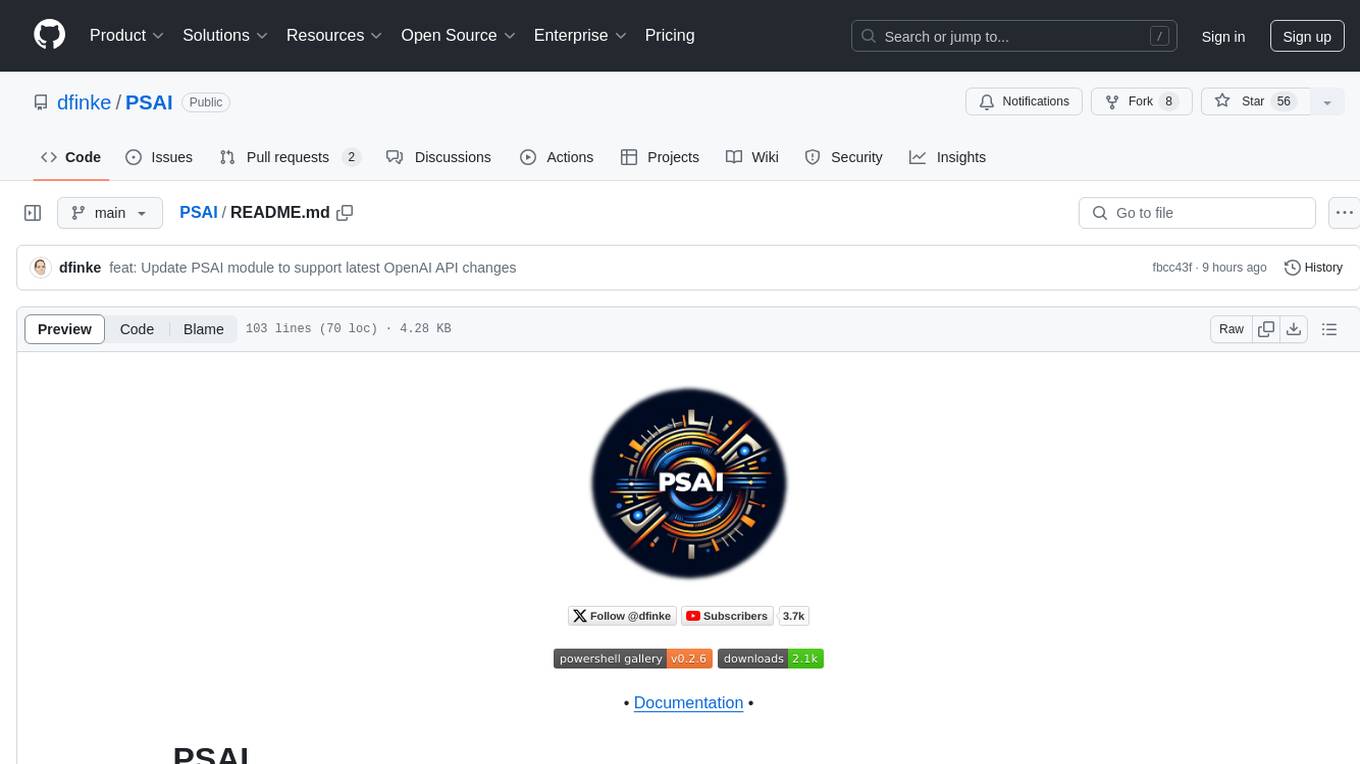
PSAI
PSAI is a PowerShell module that empowers scripts with the intelligence of OpenAI, bridging the gap between PowerShell and AI. It enables seamless integration for tasks like file searches and data analysis, revolutionizing automation possibilities with just a few lines of code. The module supports the latest OpenAI API changes, offering features like improved file search, vector store objects, token usage control, message limits, tool choice parameter, custom conversation histories, and model configuration parameters.

kaito
Kaito is an operator that automates the AI/ML inference model deployment in a Kubernetes cluster. It manages large model files using container images, avoids tuning deployment parameters to fit GPU hardware by providing preset configurations, auto-provisions GPU nodes based on model requirements, and hosts large model images in the public Microsoft Container Registry (MCR) if the license allows. Using Kaito, the workflow of onboarding large AI inference models in Kubernetes is largely simplified.
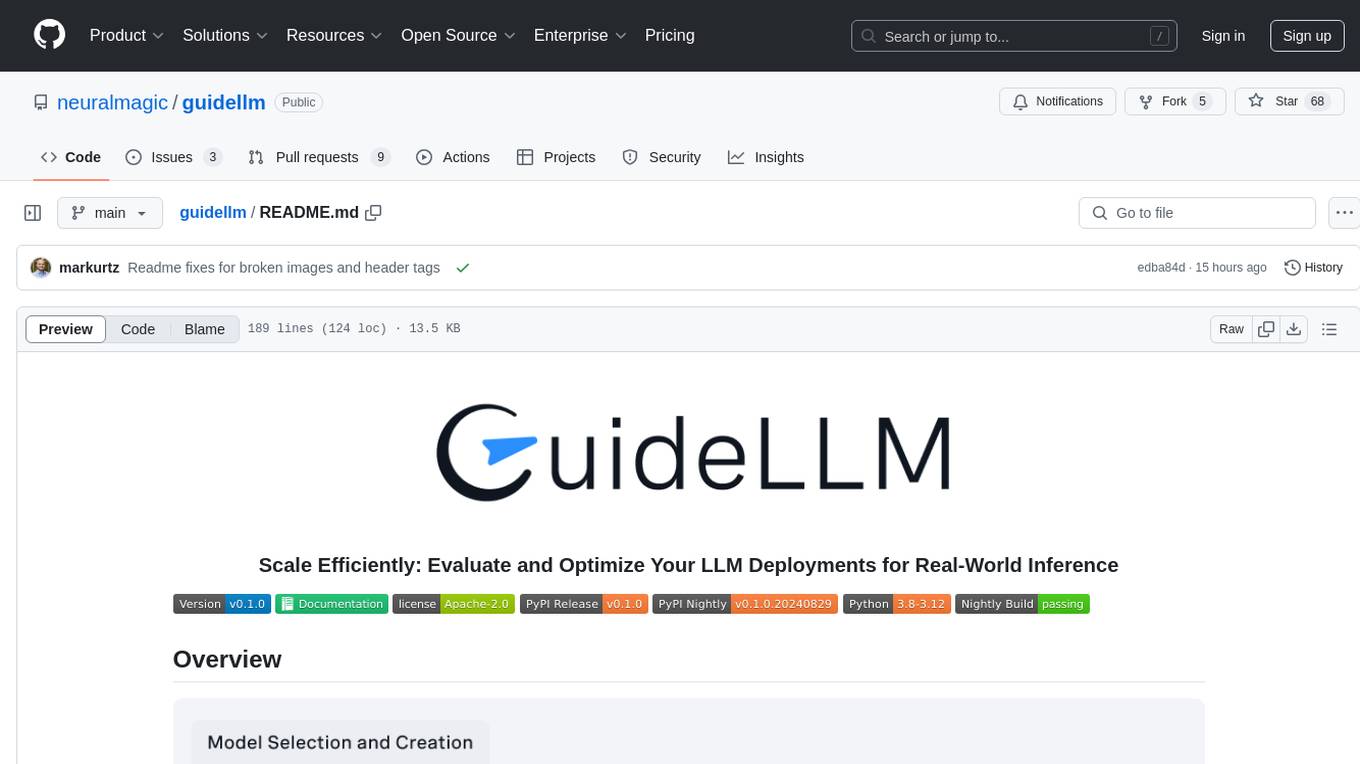
guidellm
GuideLLM is a powerful tool for evaluating and optimizing the deployment of large language models (LLMs). By simulating real-world inference workloads, GuideLLM helps users gauge the performance, resource needs, and cost implications of deploying LLMs on various hardware configurations. This approach ensures efficient, scalable, and cost-effective LLM inference serving while maintaining high service quality. Key features include performance evaluation, resource optimization, cost estimation, and scalability testing.
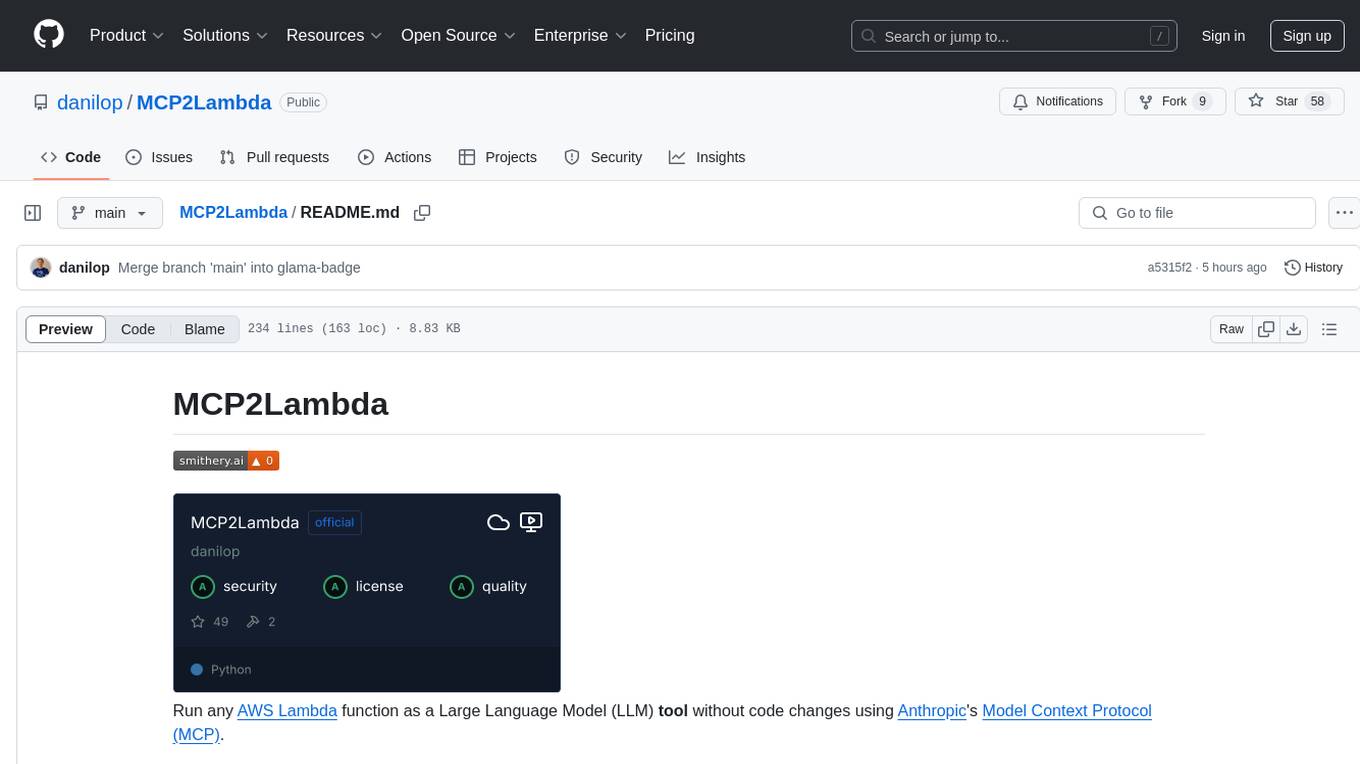
MCP2Lambda
MCP2Lambda is a server that acts as a bridge between MCP clients and AWS Lambda functions, allowing generative AI models to access and run Lambda functions as tools. It enables Large Language Models (LLMs) to interact with Lambda functions without code changes, providing access to private resources, AWS services, private networks, and the public internet. The server supports autodiscovery of Lambda functions and their invocation by name with parameters. It standardizes AI model access to external tools using the MCP protocol.
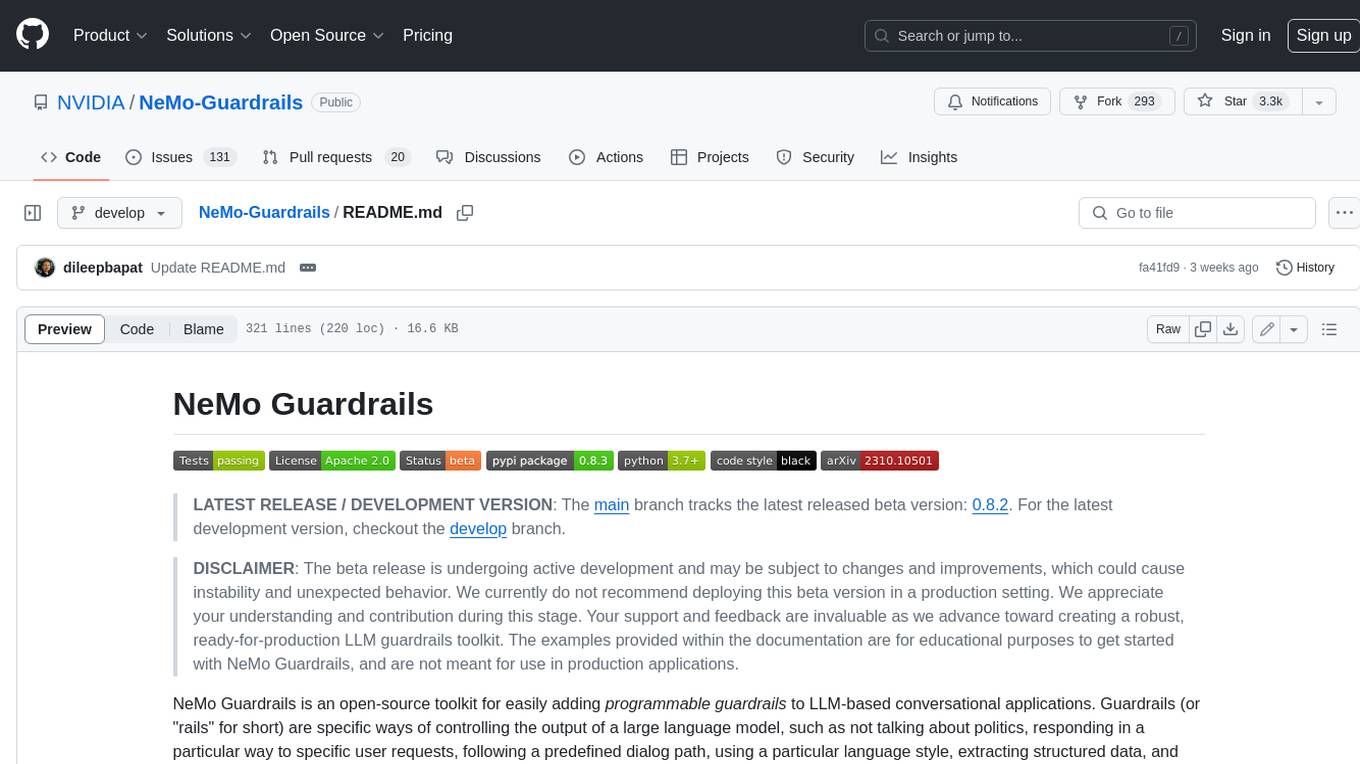
Guardrails
Guardrails is a security tool designed to help developers identify and fix security vulnerabilities in their code. It provides automated scanning and analysis of code repositories to detect potential security issues, such as sensitive data exposure, injection attacks, and insecure configurations. By integrating Guardrails into the development workflow, teams can proactively address security concerns and reduce the risk of security breaches. The tool offers detailed reports and actionable recommendations to guide developers in remediation efforts, ultimately improving the overall security posture of the codebase. Guardrails supports multiple programming languages and frameworks, making it versatile and adaptable to different development environments. With its user-friendly interface and seamless integration with popular version control systems, Guardrails empowers developers to prioritize security without compromising productivity.
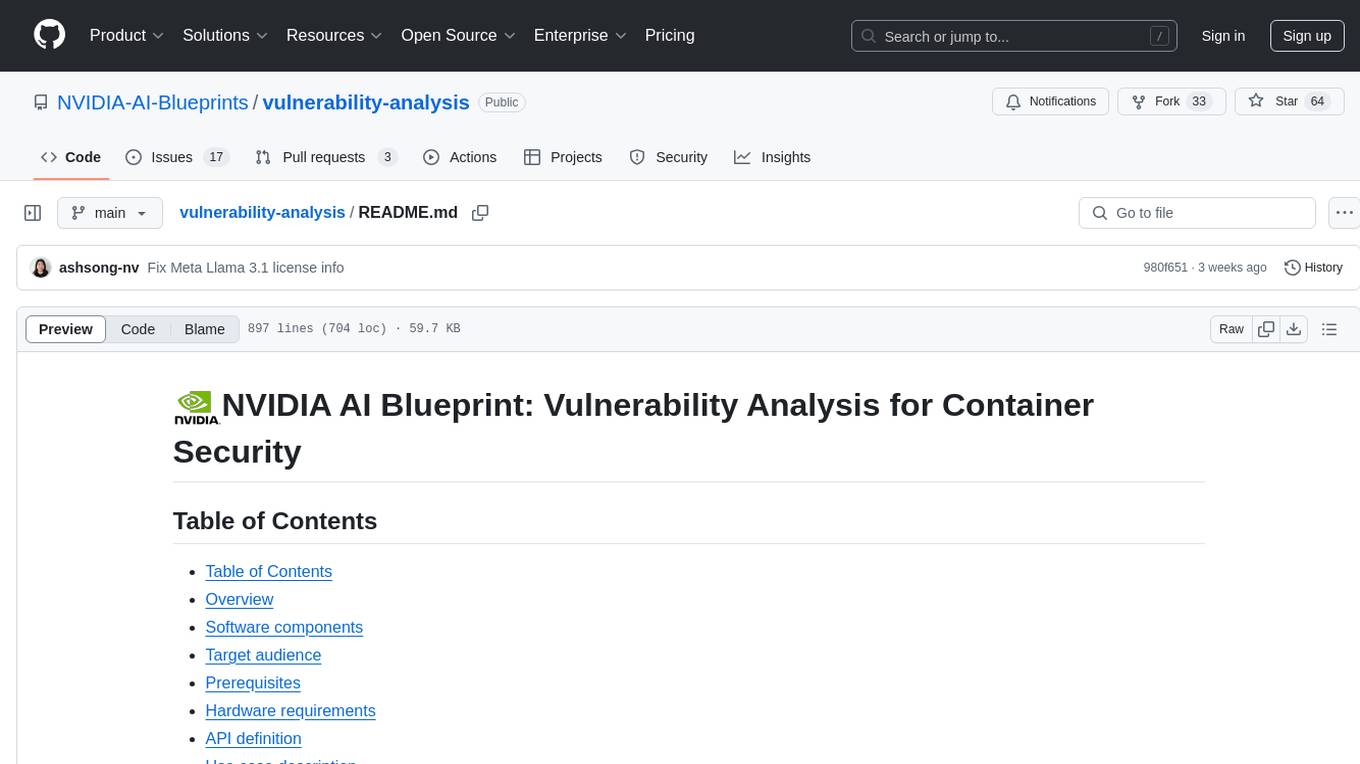
vulnerability-analysis
The NVIDIA AI Blueprint for Vulnerability Analysis for Container Security showcases accelerated analysis on common vulnerabilities and exposures (CVE) at an enterprise scale, reducing mitigation time from days to seconds. It enables security analysts to determine software package vulnerabilities using large language models (LLMs) and retrieval-augmented generation (RAG). The blueprint is designed for security analysts, IT engineers, and AI practitioners in cybersecurity. It requires NVAIE developer license and API keys for vulnerability databases, search engines, and LLM model services. Hardware requirements include L40 GPU for pipeline operation and optional LLM NIM and Embedding NIM. The workflow involves LLM pipeline for CVE impact analysis, utilizing LLM planner, agent, and summarization nodes. The blueprint uses NVIDIA NIM microservices and Morpheus Cybersecurity AI SDK for vulnerability analysis.
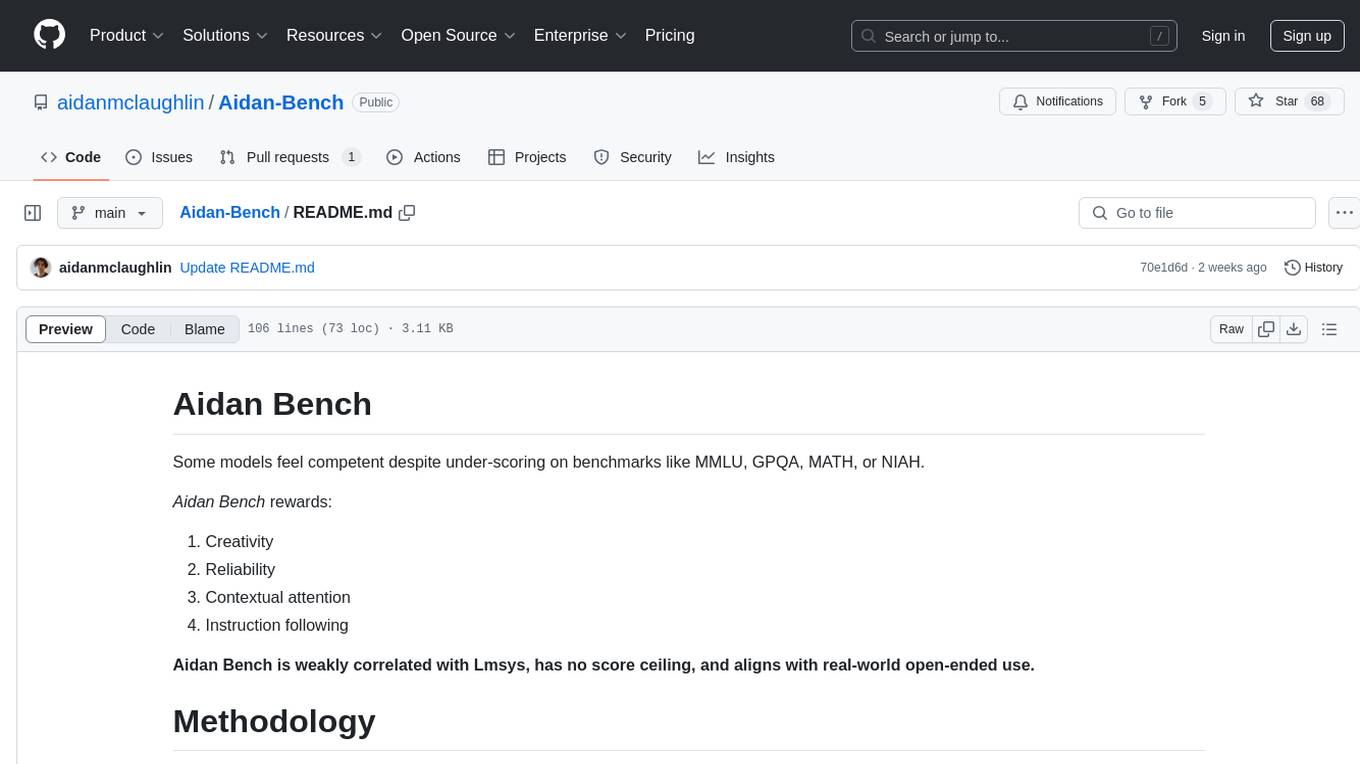
Aidan-Bench
Aidan Bench is a tool that rewards creativity, reliability, contextual attention, and instruction following. It is weakly correlated with Lmsys, has no score ceiling, and aligns with real-world open-ended use. The tool involves giving LLMs open-ended questions and evaluating their answers based on novelty scores. Users can set up the tool by installing required libraries and setting up API keys. The project allows users to run benchmarks for different models and provides flexibility in threading options.
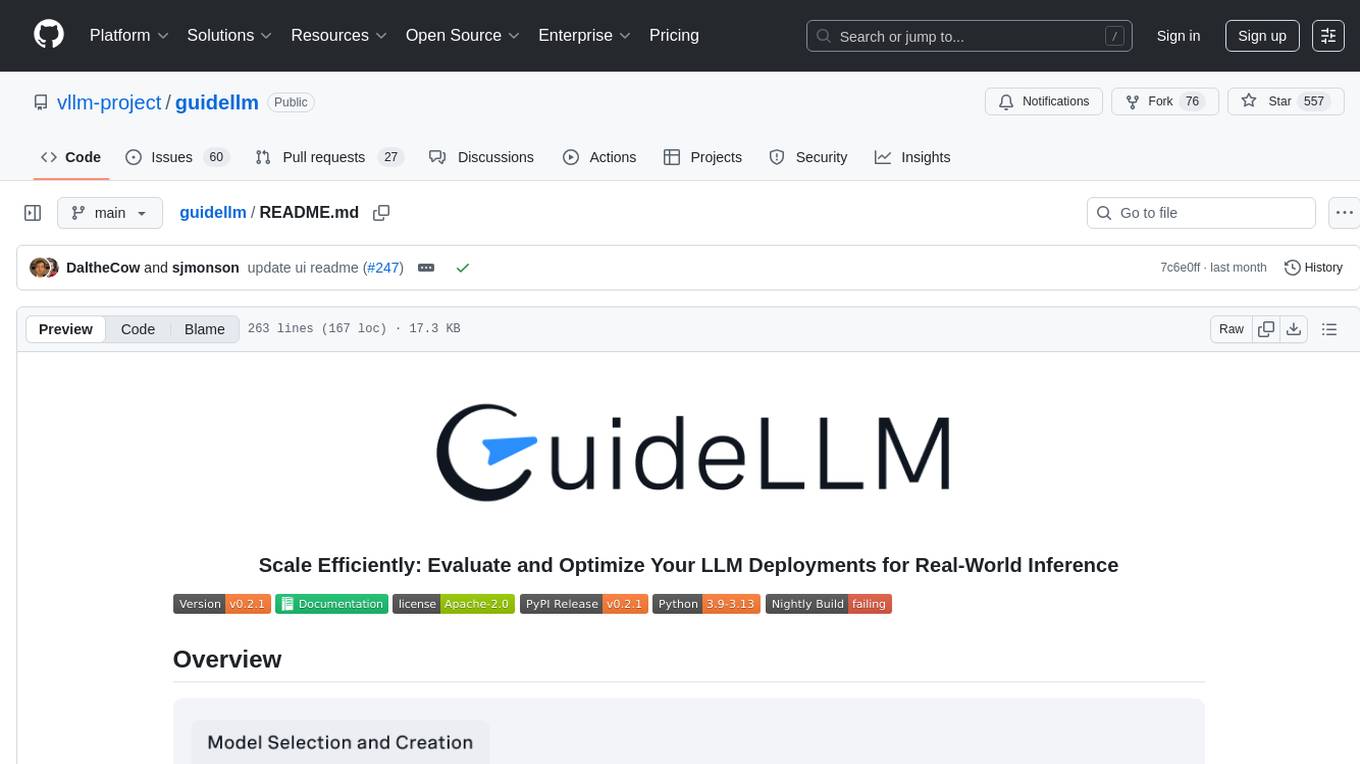
guidellm
GuideLLM is a platform for evaluating and optimizing the deployment of large language models (LLMs). By simulating real-world inference workloads, GuideLLM enables users to assess the performance, resource requirements, and cost implications of deploying LLMs on various hardware configurations. This approach ensures efficient, scalable, and cost-effective LLM inference serving while maintaining high service quality. The tool provides features for performance evaluation, resource optimization, cost estimation, and scalability testing.
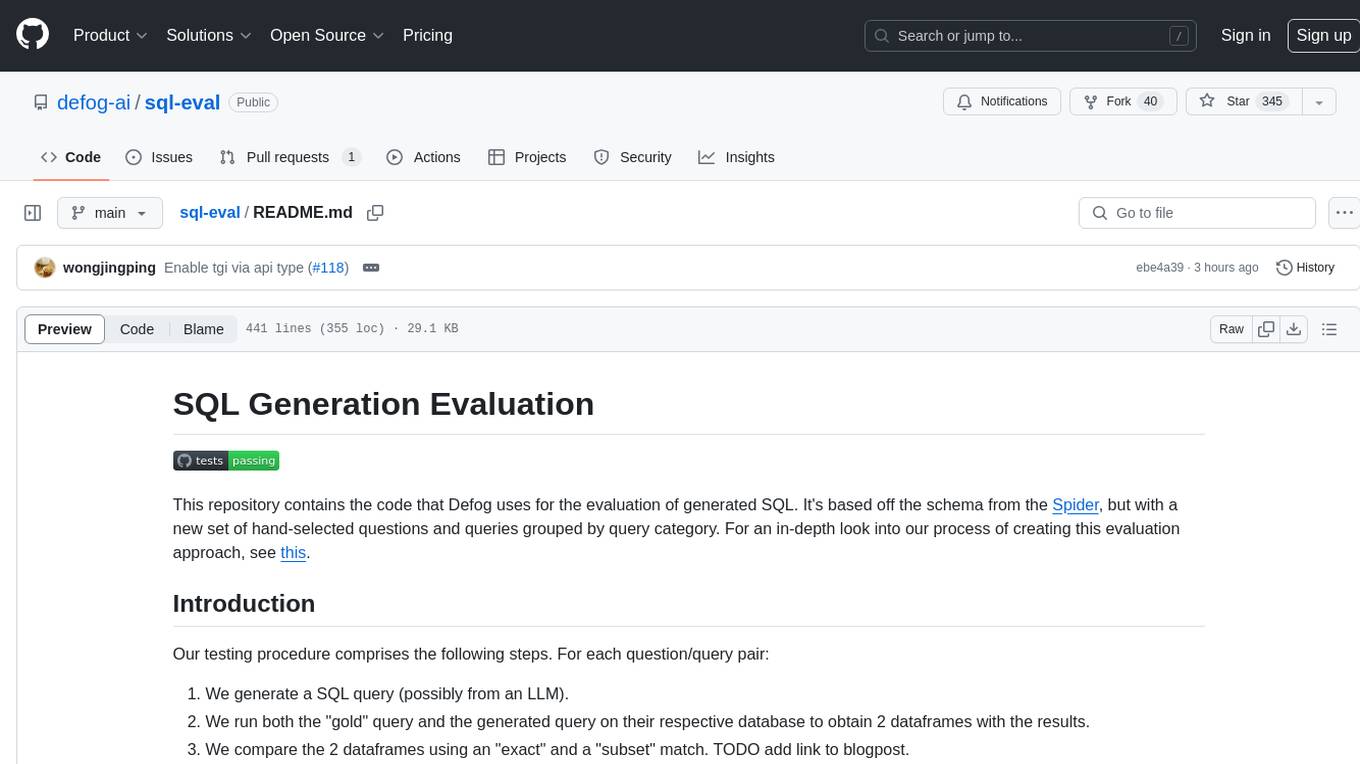
sql-eval
This repository contains the code that Defog uses for the evaluation of generated SQL. It's based off the schema from the Spider, but with a new set of hand-selected questions and queries grouped by query category. The testing procedure involves generating a SQL query, running both the 'gold' query and the generated query on their respective database to obtain dataframes with the results, comparing the dataframes using an 'exact' and a 'subset' match, logging these alongside other metrics of interest, and aggregating the results for reporting. The repository provides comprehensive instructions for installing dependencies, starting a Postgres instance, importing data into Postgres, importing data into Snowflake, using private data, implementing a query generator, and running the test with different runners.
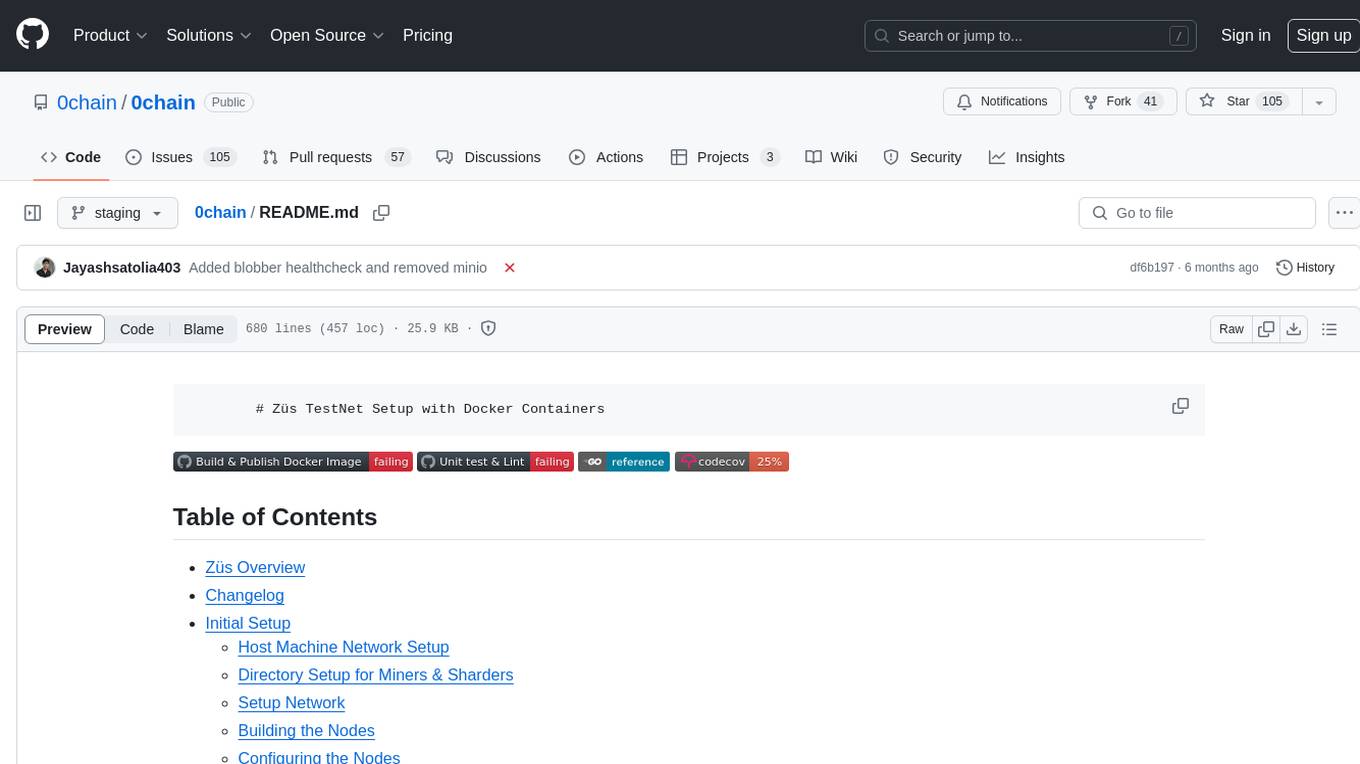
0chain
Züs is a high-performance cloud on a fast blockchain offering privacy and configurable uptime. It uses erasure code to distribute data between data and parity servers, allowing flexibility for IT managers to design for security and uptime. Users can easily share encrypted data with business partners through a proxy key sharing protocol. The ecosystem includes apps like Blimp for cloud migration, Vult for personal cloud storage, and Chalk for NFT artists. Other apps include Bolt for secure wallet and staking, Atlus for blockchain explorer, and Chimney for network participation. The QoS protocol challenges providers based on response time, while the privacy protocol enables secure data sharing. Züs supports hybrid and multi-cloud architectures, allowing users to improve regulatory compliance and security requirements.
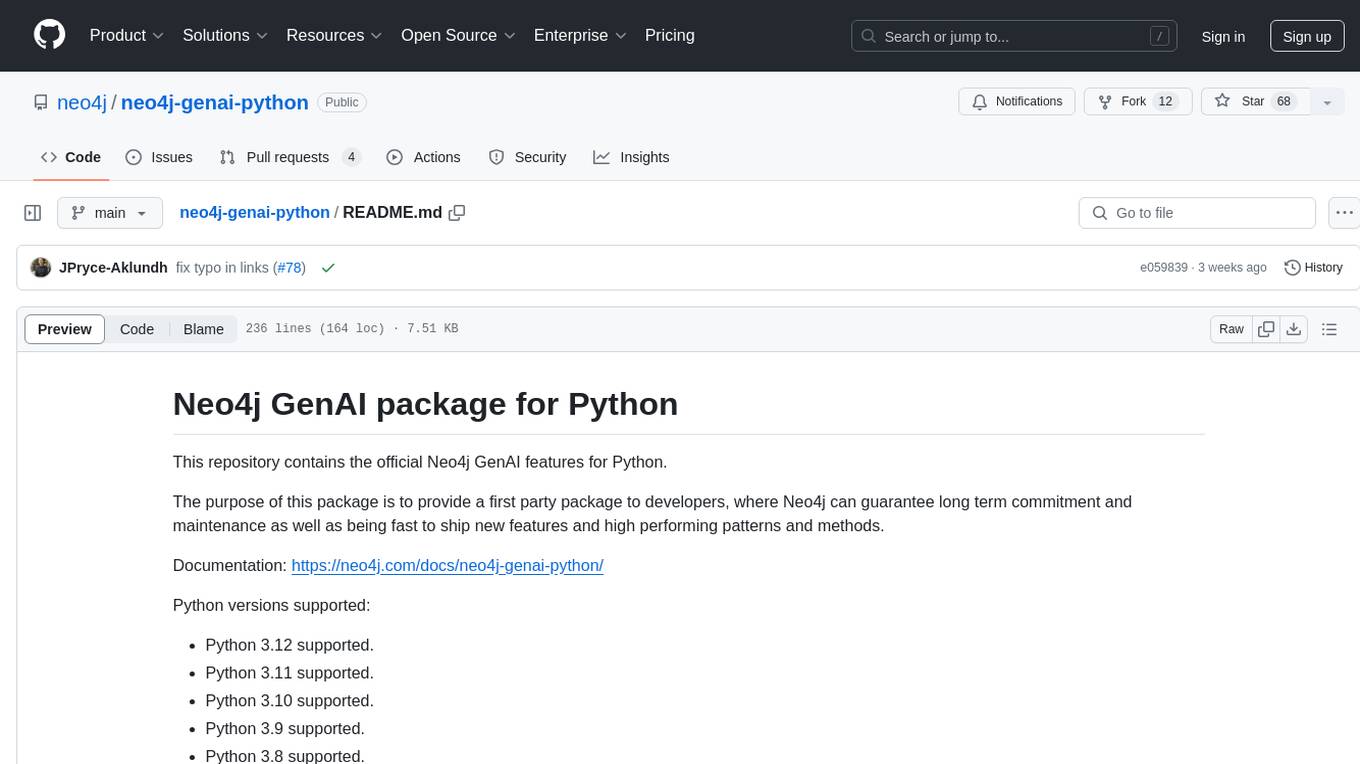
neo4j-genai-python
This repository contains the official Neo4j GenAI features for Python. The purpose of this package is to provide a first-party package to developers, where Neo4j can guarantee long-term commitment and maintenance as well as being fast to ship new features and high-performing patterns and methods.
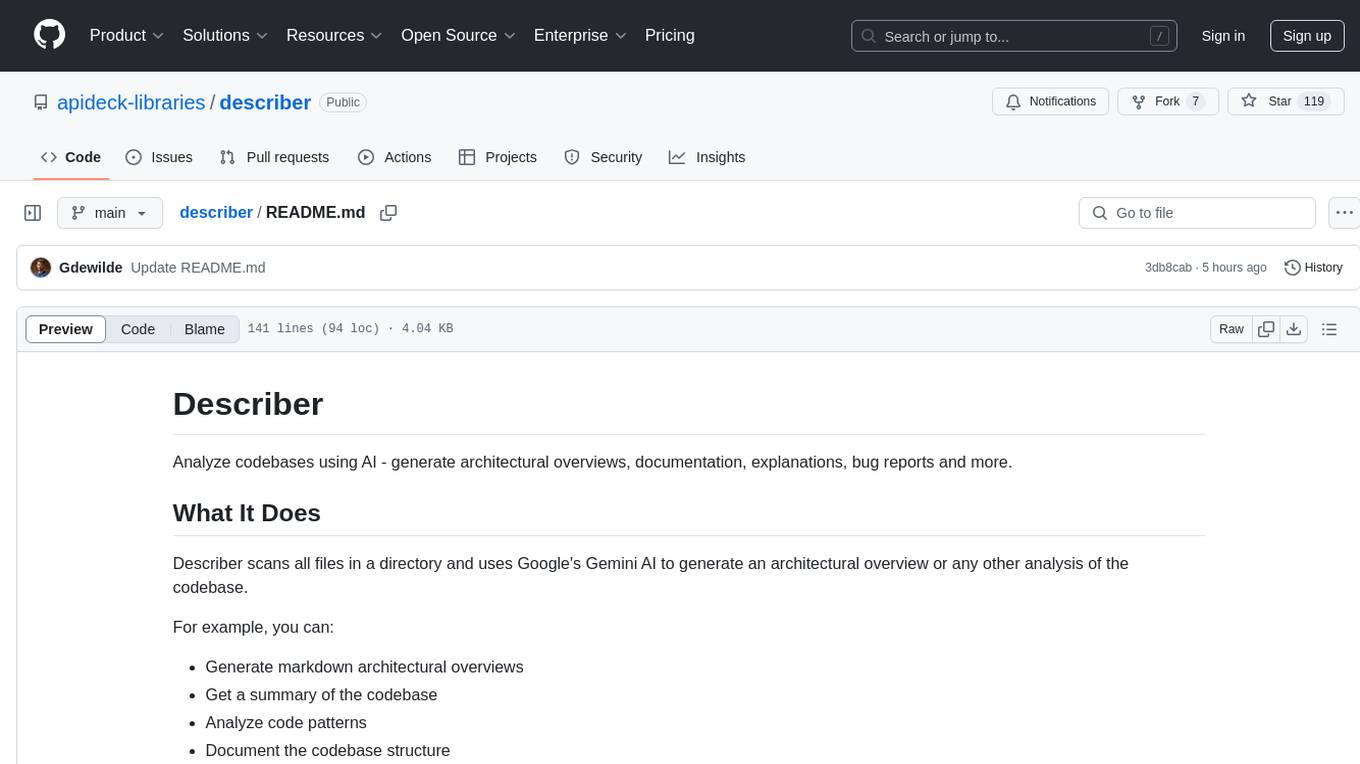
describer
Describer is a tool that analyzes codebases using AI to generate architectural overviews, documentation, explanations, bug reports, and more. It scans all files in a directory and uses Google's Gemini AI to provide insights such as markdown architectural overviews, codebase summaries, code pattern analysis, codebase structure documentation, bug identification, and test idea generation. The tool respects .gitignore rules by default but allows users to include/exclude specific files or patterns for analysis.
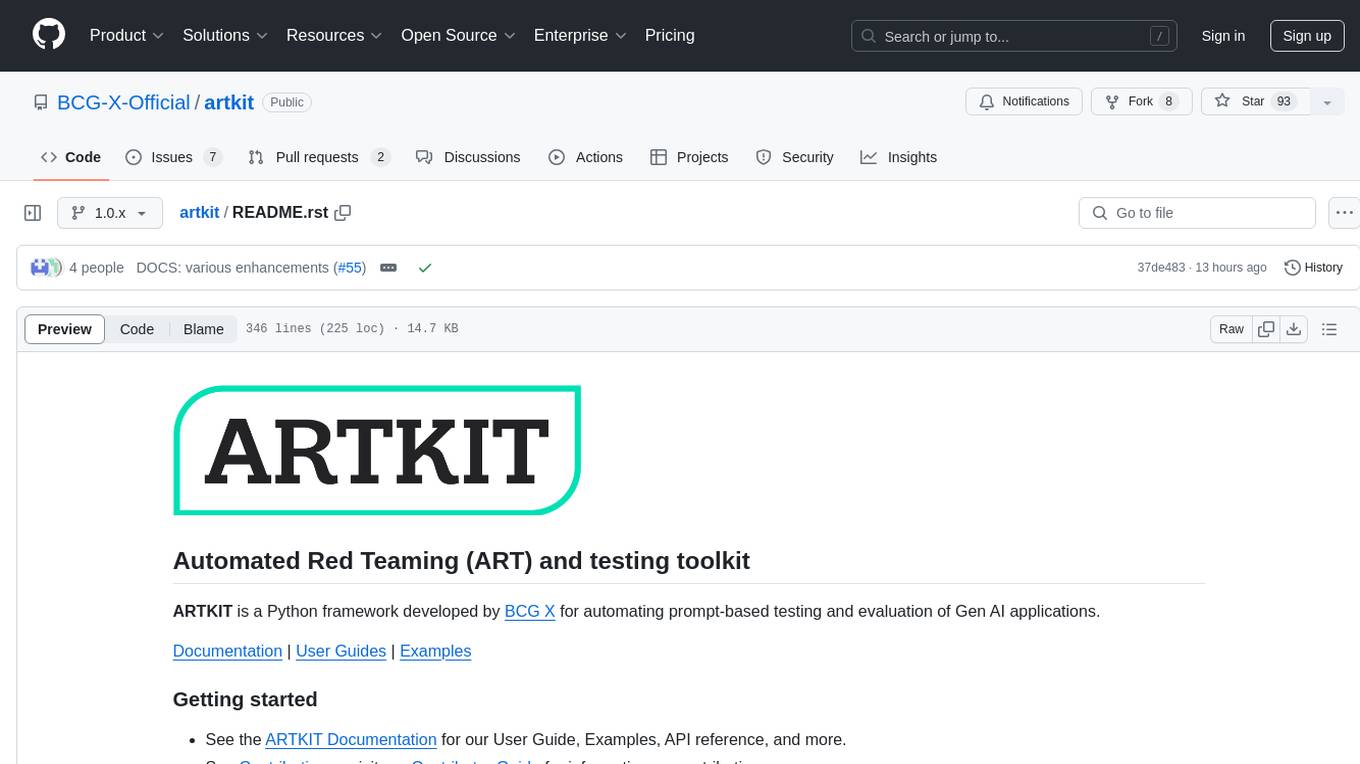
artkit
ARTKIT is a Python framework developed by BCG X for automating prompt-based testing and evaluation of Gen AI applications. It allows users to develop automated end-to-end testing and evaluation pipelines for Gen AI systems, supporting multi-turn conversations and various testing scenarios like Q&A accuracy, brand values, equitability, safety, and security. The framework provides a simple API, asynchronous processing, caching, model agnostic support, end-to-end pipelines, multi-turn conversations, robust data flows, and visualizations. ARTKIT is designed for customization by data scientists and engineers to enhance human-in-the-loop testing and evaluation, emphasizing the importance of tailored testing for each Gen AI use case.
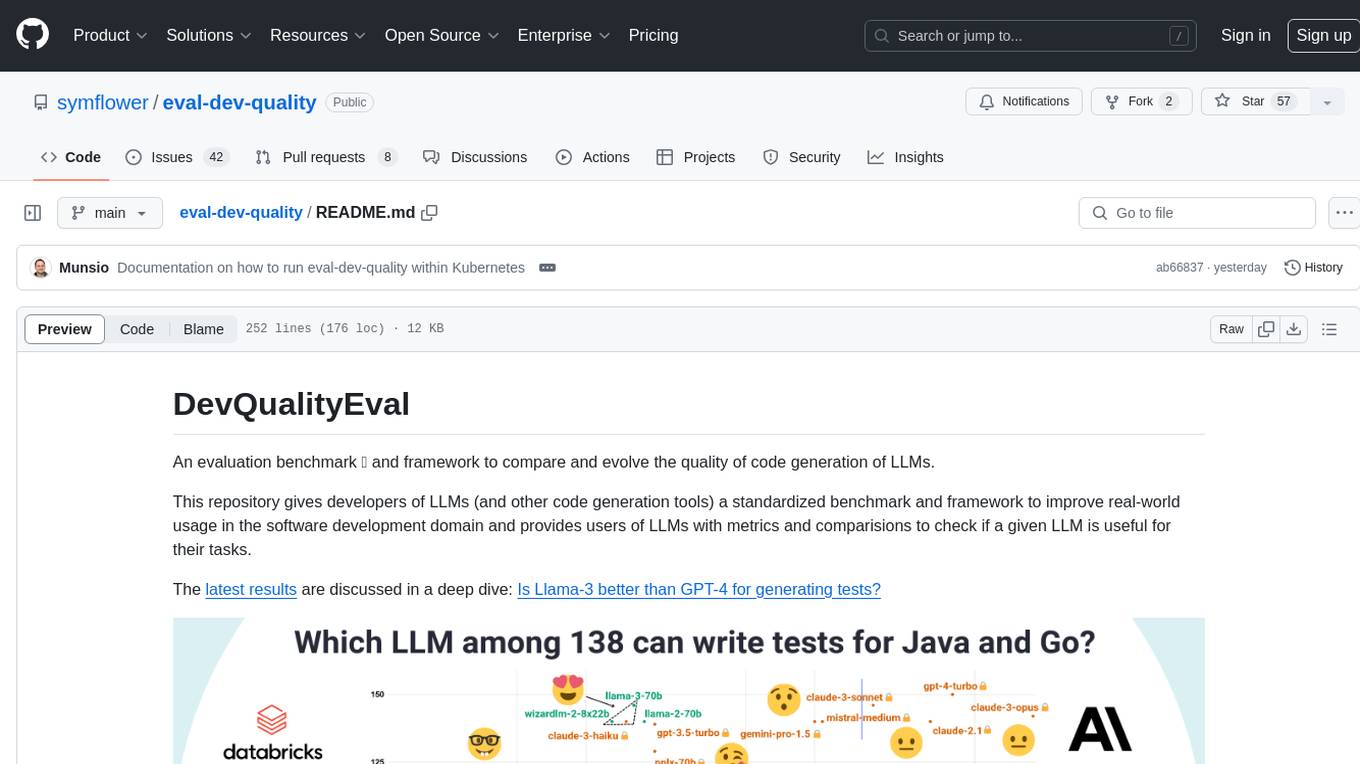
eval-dev-quality
DevQualityEval is an evaluation benchmark and framework designed to compare and improve the quality of code generation of Language Model Models (LLMs). It provides developers with a standardized benchmark to enhance real-world usage in software development and offers users metrics and comparisons to assess the usefulness of LLMs for their tasks. The tool evaluates LLMs' performance in solving software development tasks and measures the quality of their results through a point-based system. Users can run specific tasks, such as test generation, across different programming languages to evaluate LLMs' language understanding and code generation capabilities.
For similar tasks

LESS
This repository contains the code for the paper 'LESS: Selecting Influential Data for Targeted Instruction Tuning'. The work proposes a data selection method to choose influential data for inducing a target capability. It includes steps for warmup training, building the gradient datastore, selecting data for a task, and training with the selected data. The repository provides tools for data preparation, data selection pipeline, and evaluation of the model trained on the selected data.
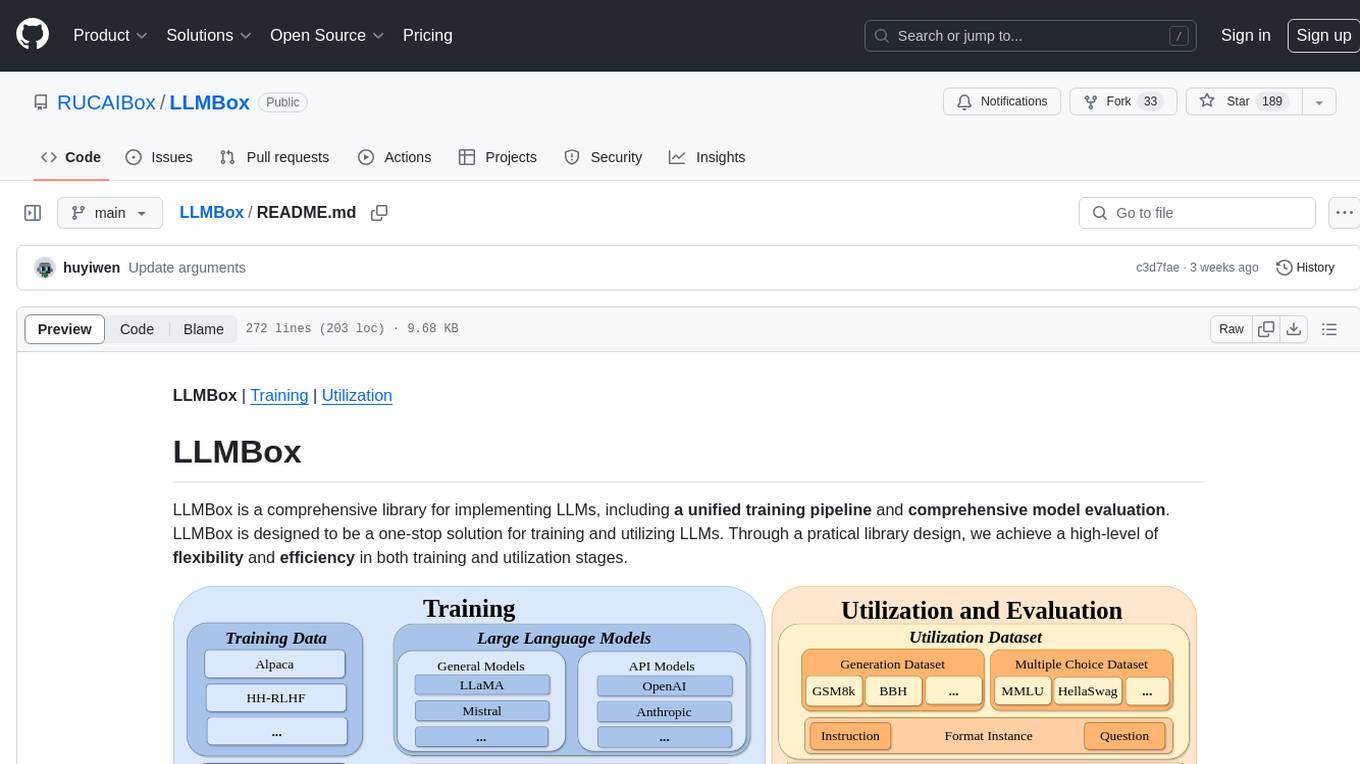
LLMBox
LLMBox is a comprehensive library designed for implementing Large Language Models (LLMs) with a focus on a unified training pipeline and comprehensive model evaluation. It serves as a one-stop solution for training and utilizing LLMs, offering flexibility and efficiency in both training and utilization stages. The library supports diverse training strategies, comprehensive datasets, tokenizer vocabulary merging, data construction strategies, parameter efficient fine-tuning, and efficient training methods. For utilization, LLMBox provides comprehensive evaluation on various datasets, in-context learning strategies, chain-of-thought evaluation, evaluation methods, prefix caching for faster inference, support for specific LLM models like vLLM and Flash Attention, and quantization options. The tool is suitable for researchers and developers working with LLMs for natural language processing tasks.
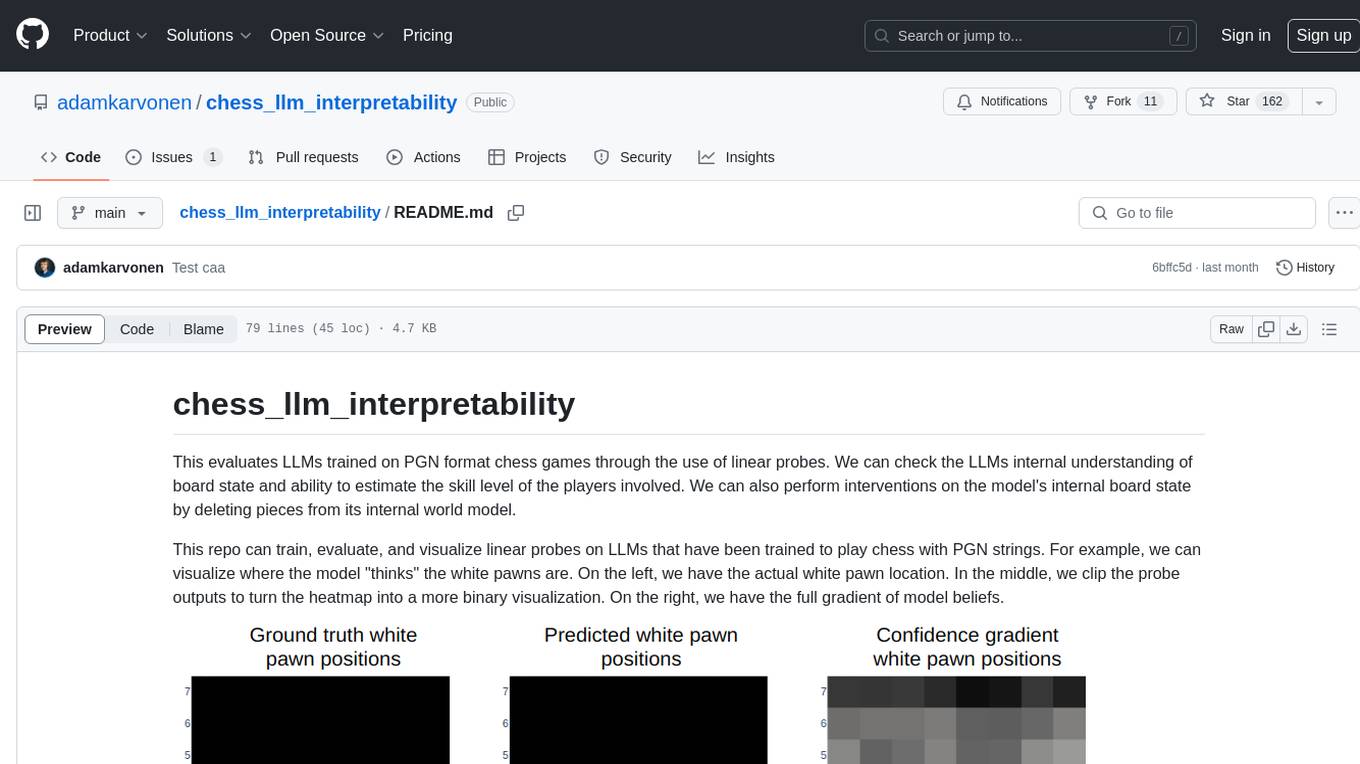
chess_llm_interpretability
This repository evaluates Large Language Models (LLMs) trained on PGN format chess games using linear probes. It assesses the LLMs' internal understanding of board state and their ability to estimate player skill levels. The repo provides tools to train, evaluate, and visualize linear probes on LLMs trained to play chess with PGN strings. Users can visualize the model's predictions, perform interventions on the model's internal board state, and analyze board state and player skill level accuracy across different LLMs. The experiments in the repo can be conducted with less than 1 GB of VRAM, and training probes on the 8 layer model takes about 10 minutes on an RTX 3050. The repo also includes scripts for performing board state interventions and skill interventions, along with useful links to open-source code, models, datasets, and pretrained models.
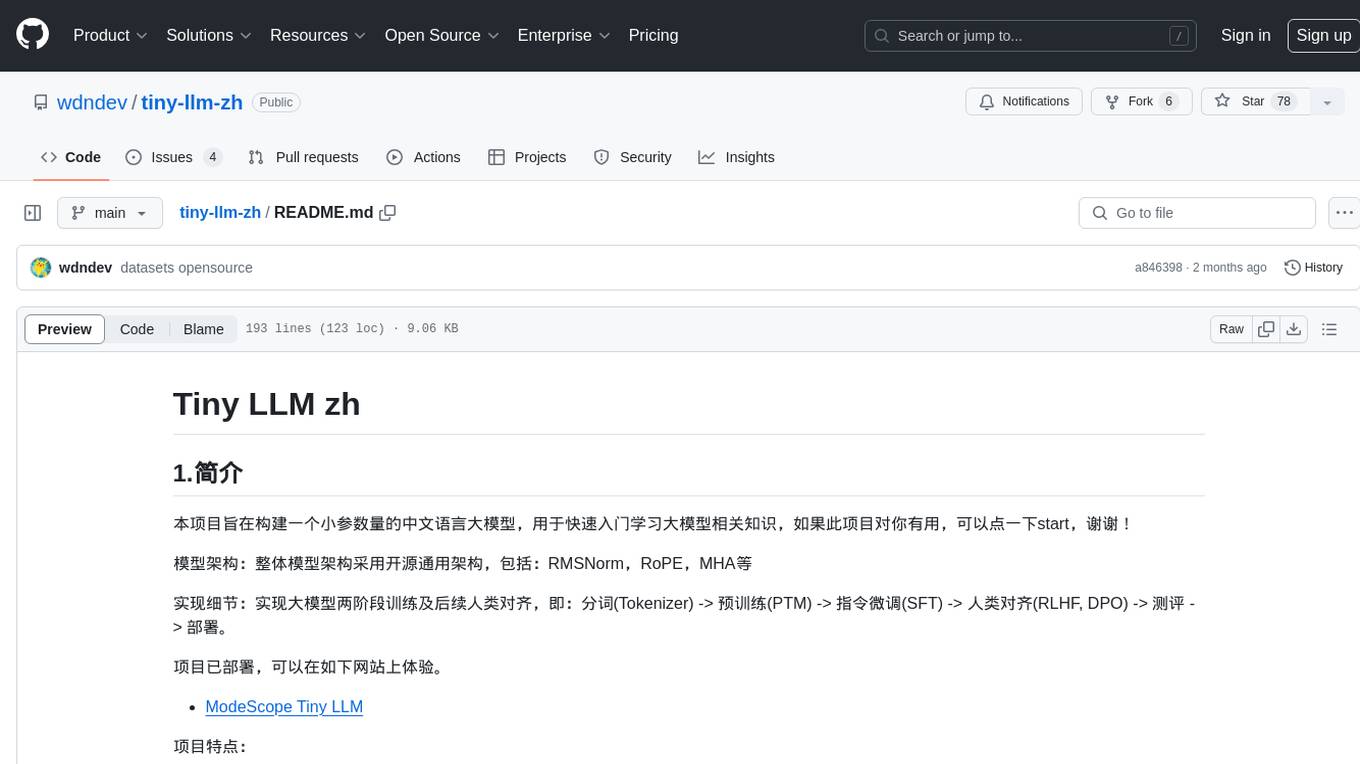
tiny-llm-zh
Tiny LLM zh is a project aimed at building a small-parameter Chinese language large model for quick entry into learning large model-related knowledge. The project implements a two-stage training process for large models and subsequent human alignment, including tokenization, pre-training, instruction fine-tuning, human alignment, evaluation, and deployment. It is deployed on ModeScope Tiny LLM website and features open access to all data and code, including pre-training data and tokenizer. The project trains a tokenizer using 10GB of Chinese encyclopedia text to build a Tiny LLM vocabulary. It supports training with Transformers deepspeed, multiple machine and card support, and Zero optimization techniques. The project has three main branches: llama2_torch, main tiny_llm, and tiny_llm_moe, each with specific modifications and features.
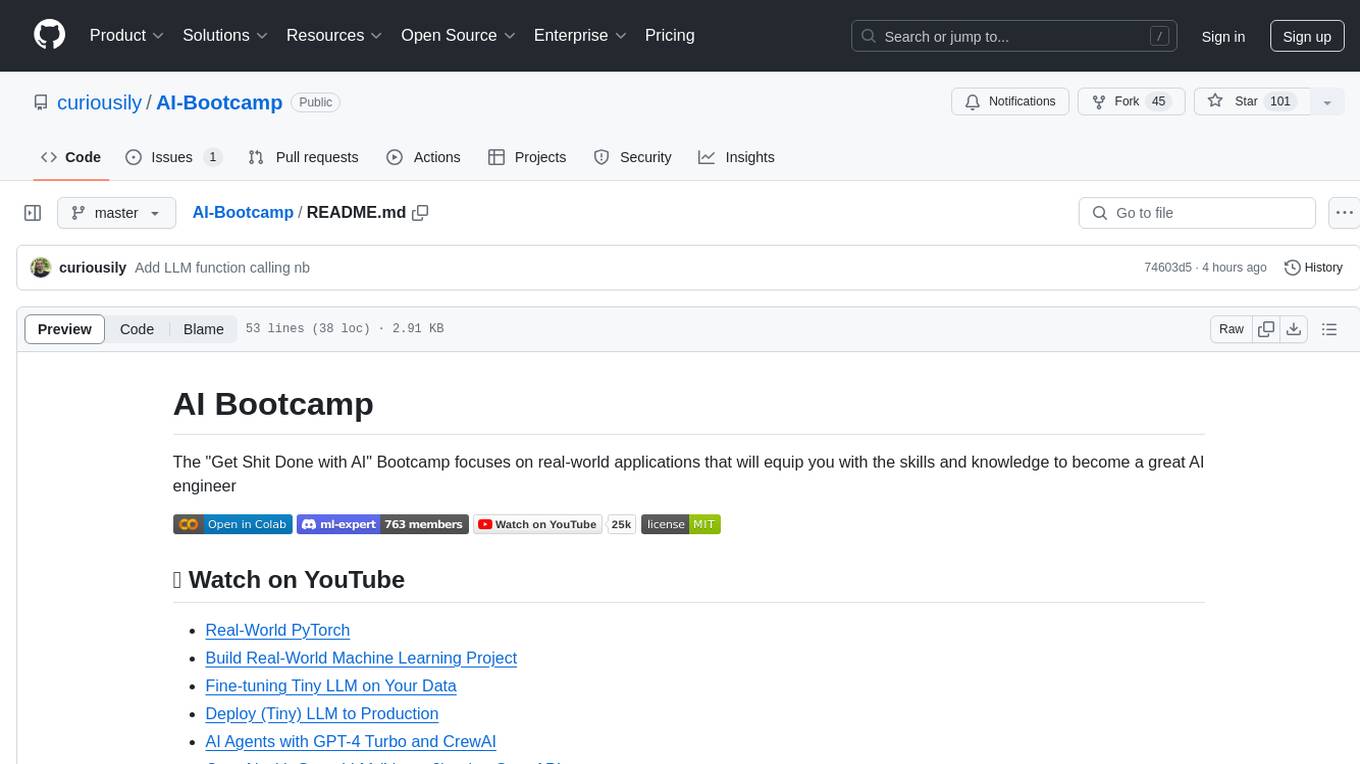
AI-Bootcamp
The AI Bootcamp is a comprehensive training program focusing on real-world applications to equip individuals with the skills and knowledge needed to excel as AI engineers. The bootcamp covers topics such as Real-World PyTorch, Machine Learning Projects, Fine-tuning Tiny LLM, Deployment of LLM to Production, AI Agents with GPT-4 Turbo, CrewAI, Llama 3, and more. Participants will learn foundational skills in Python for AI, ML Pipelines, Large Language Models (LLMs), AI Agents, and work on projects like RagBase for private document chat.
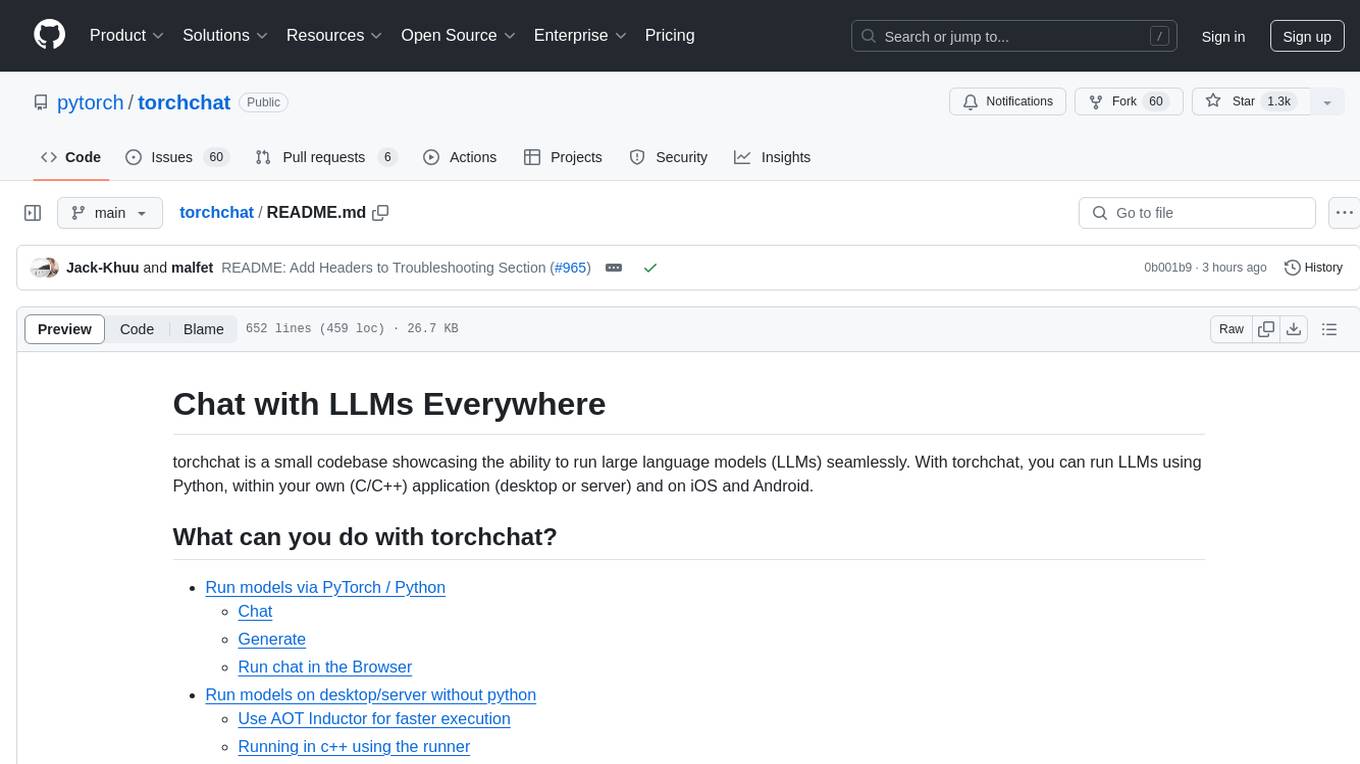
torchchat
torchchat is a codebase showcasing the ability to run large language models (LLMs) seamlessly. It allows running LLMs using Python in various environments such as desktop, server, iOS, and Android. The tool supports running models via PyTorch, chatting, generating text, running chat in the browser, and running models on desktop/server without Python. It also provides features like AOT Inductor for faster execution, running in C++ using the runner, and deploying and running on iOS and Android. The tool supports popular hardware and OS including Linux, Mac OS, Android, and iOS, with various data types and execution modes available.
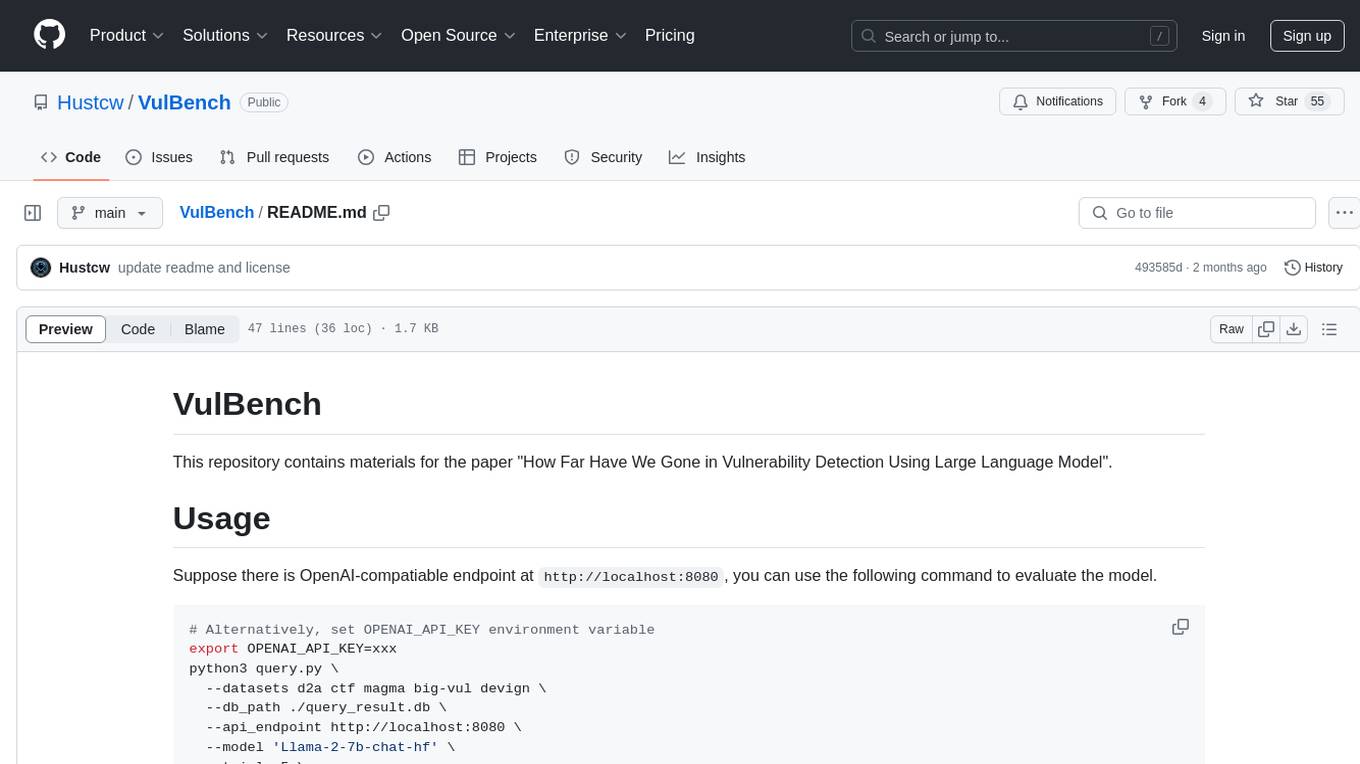
VulBench
This repository contains materials for the paper 'How Far Have We Gone in Vulnerability Detection Using Large Language Model'. It provides a tool for evaluating vulnerability detection models using datasets such as d2a, ctf, magma, big-vul, and devign. Users can query the model 'Llama-2-7b-chat-hf' and store results in a SQLite database for analysis. The tool supports binary and multiple classification tasks with concurrency settings. Additionally, users can evaluate the results and generate a CSV file with metrics for each dataset and prompt type.
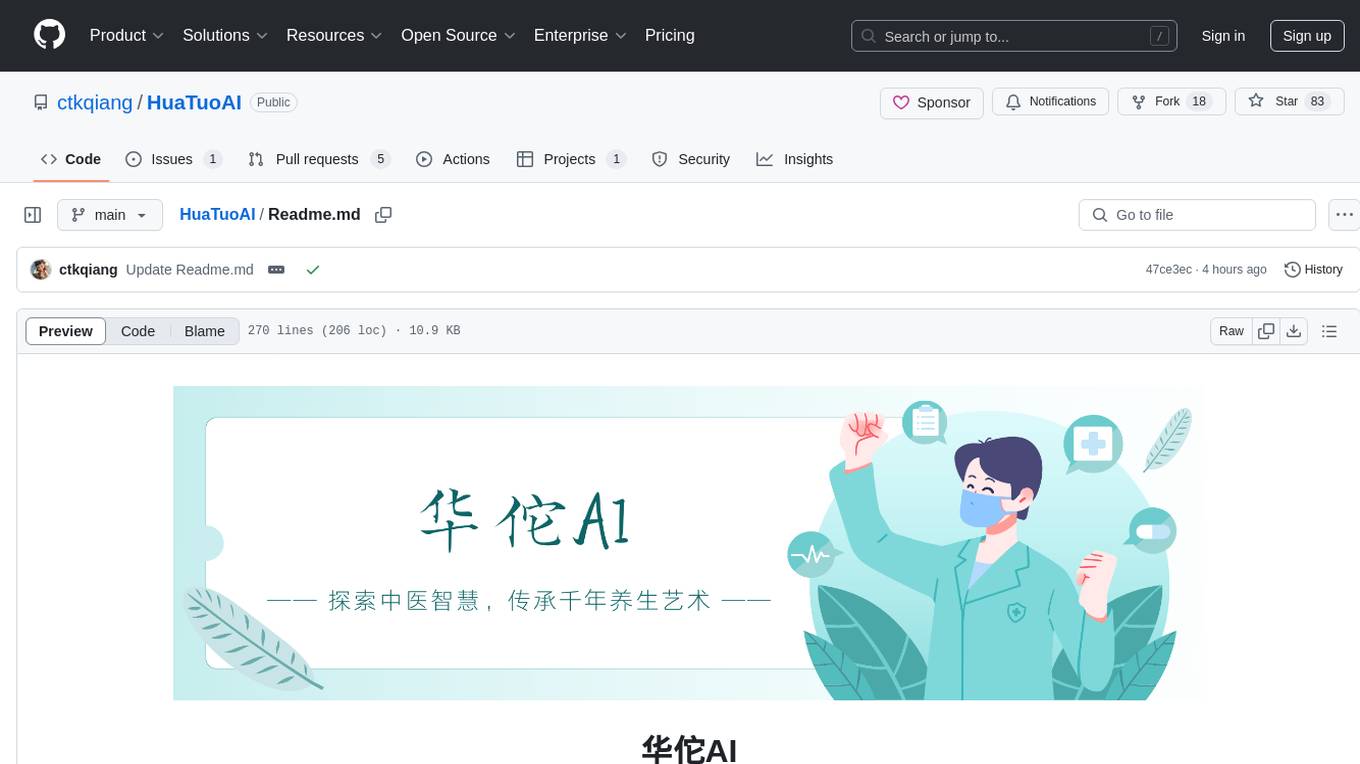
HuaTuoAI
HuaTuoAI is an artificial intelligence image classification system specifically designed for traditional Chinese medicine. It utilizes deep learning techniques, such as Convolutional Neural Networks (CNN), to accurately classify Chinese herbs and ingredients based on input images. The project aims to unlock the secrets of plants, depict the unknown realm of Chinese medicine using technology and intelligence, and perpetuate ancient cultural heritage.
For similar jobs

sweep
Sweep is an AI junior developer that turns bugs and feature requests into code changes. It automatically handles developer experience improvements like adding type hints and improving test coverage.

teams-ai
The Teams AI Library is a software development kit (SDK) that helps developers create bots that can interact with Teams and Microsoft 365 applications. It is built on top of the Bot Framework SDK and simplifies the process of developing bots that interact with Teams' artificial intelligence capabilities. The SDK is available for JavaScript/TypeScript, .NET, and Python.

ai-guide
This guide is dedicated to Large Language Models (LLMs) that you can run on your home computer. It assumes your PC is a lower-end, non-gaming setup.

classifai
Supercharge WordPress Content Workflows and Engagement with Artificial Intelligence. Tap into leading cloud-based services like OpenAI, Microsoft Azure AI, Google Gemini and IBM Watson to augment your WordPress-powered websites. Publish content faster while improving SEO performance and increasing audience engagement. ClassifAI integrates Artificial Intelligence and Machine Learning technologies to lighten your workload and eliminate tedious tasks, giving you more time to create original content that matters.

chatbot-ui
Chatbot UI is an open-source AI chat app that allows users to create and deploy their own AI chatbots. It is easy to use and can be customized to fit any need. Chatbot UI is perfect for businesses, developers, and anyone who wants to create a chatbot.

BricksLLM
BricksLLM is a cloud native AI gateway written in Go. Currently, it provides native support for OpenAI, Anthropic, Azure OpenAI and vLLM. BricksLLM aims to provide enterprise level infrastructure that can power any LLM production use cases. Here are some use cases for BricksLLM: * Set LLM usage limits for users on different pricing tiers * Track LLM usage on a per user and per organization basis * Block or redact requests containing PIIs * Improve LLM reliability with failovers, retries and caching * Distribute API keys with rate limits and cost limits for internal development/production use cases * Distribute API keys with rate limits and cost limits for students

uAgents
uAgents is a Python library developed by Fetch.ai that allows for the creation of autonomous AI agents. These agents can perform various tasks on a schedule or take action on various events. uAgents are easy to create and manage, and they are connected to a fast-growing network of other uAgents. They are also secure, with cryptographically secured messages and wallets.

griptape
Griptape is a modular Python framework for building AI-powered applications that securely connect to your enterprise data and APIs. It offers developers the ability to maintain control and flexibility at every step. Griptape's core components include Structures (Agents, Pipelines, and Workflows), Tasks, Tools, Memory (Conversation Memory, Task Memory, and Meta Memory), Drivers (Prompt and Embedding Drivers, Vector Store Drivers, Image Generation Drivers, Image Query Drivers, SQL Drivers, Web Scraper Drivers, and Conversation Memory Drivers), Engines (Query Engines, Extraction Engines, Summary Engines, Image Generation Engines, and Image Query Engines), and additional components (Rulesets, Loaders, Artifacts, Chunkers, and Tokenizers). Griptape enables developers to create AI-powered applications with ease and efficiency.